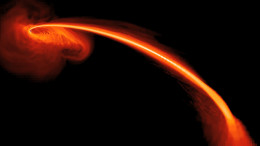Close encounters between stars and supermassive black holes generally don’t end well for the stars. Under the influence of a black hole’s strong gravitational forces, an unsuspecting passing star can be completely shredded, resulting in a spectacular tidal disruption flare. But what happens when the star is only partially destroyed?
Unfortunate Encounters

This simulated TDE shows the looping tidal stream caused when a star is pulled apart by the gravitational forces of a black hole. When this stream intersects with itself, material collides and rains onto the black hole, causing it to light up. [NASA/S. Gezari (JHU)/J. Guillochon (UCSC)]
During a TDE, a passing star is torn apart and stretched into a stream of debris by the tidal forces of the supermassive black hole. Part of this stellar material escapes the black hole’s pull and scatters; the rest collides with itself during looping orbits, eventually raining down on the black hole and accreting. This accretion emits radiation, causing the black hole to briefly flare, producing a characteristic light curve that we might observe.
A Universal Decay?
The shape of the light curve is what makes TDEs distinctive. When we search for tidal flares, we hunt for transient signals that feature a sharp rise in the light curve followed by a long, decaying tail with a shape that’s governed by the physics of the fallback and accretion of the stellar material. For TDEs, that decay asymptotes to a characteristic power-law slope — a slope that was thought to be universal for all such stellar destruction.
But is it truly? A new study by scientists Eric Coughlin (Princeton University; Columbia Astrophysics Laboratory) and Chris Nixon (University of Leicester) explores whether we can expect to see differences when a star is only partially destroyed in its encounter with a supermassive black hole.
Survival Under Stress

Fallback rate onto a million-solar-mass supermassive black hole as a function of time for a disrupted Sun-like star. Different color curves represent different masses of surviving stellar cores. The curve representing a fully destroyed star (µ=0, red) asymptotes to a shallower slope (~t-5/3). The other curves, which all represent partial disruptions of varying degrees, all asymptote to a more steeply decaying slope (~t-9/4). Click to enlarge. [Coughlin & Nixon 2019]
What does this mean for observations? The authors argue that we should expect to see two types of TDEs: those representing complete stellar disruptions, whose light curves asymptote to a shallower slope, and those representing partial stellar disruptions, whose light curves asymptote to a steeper slope.
Coughlin and Nixon estimate that, for stars that undergo tidal disruptions, just under half of low-mass stars and around 70% of high-mass stars will be only partially disrupted. They therefore expect that a substantial fraction of TDEs detected by future facilities — like the Large Synoptic Survey Telescope (LSST) coming online in 2020 — will represent stars that partially survived their close encounter with a supermassive black hole … though perhaps a little the worse for wear.
Citation
“Partial Stellar Disruption by a Supermassive Black Hole: Is the Light Curve Really Proportional to t −9/4?,” Eric R. Coughlin and C. J. Nixon 2019 ApJL 883 L17. doi:10.3847/2041-8213/ab412d
